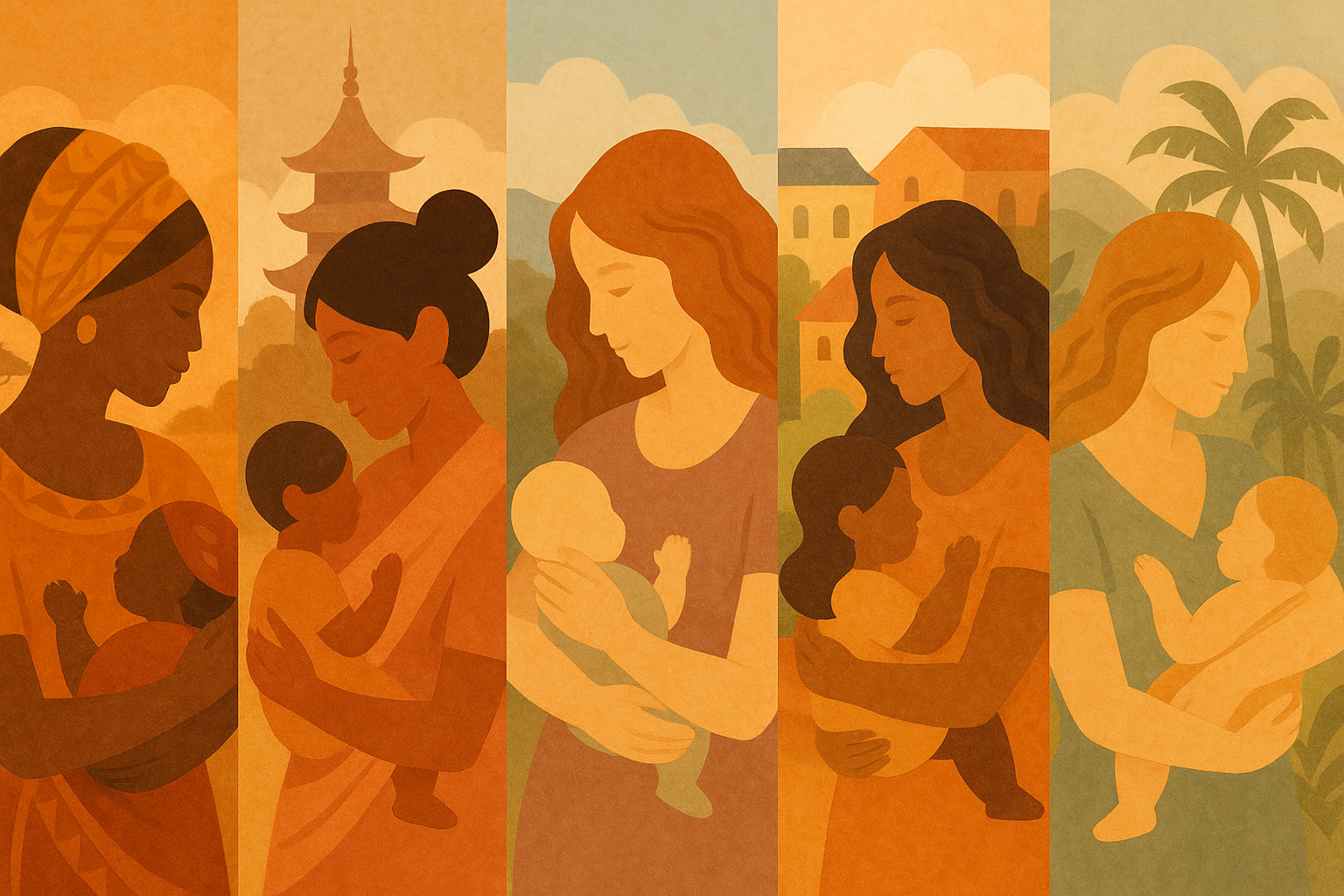Breastfeeding Across Borders: A Window into Global Motherhood

Stepping back to look at breastfeeding practices worldwide reveals a fascinating tapestry of cultural attitudes, policy impacts, and the universal challenges mothers face. Understanding these global patterns can help us appreciate different approaches and learn from what works—and what doesn’t—around the world.
The Global Picture: Unity in Diversity
According to CNN’s global analysis, 95% of babies worldwide are breastfed at some point in their lives. This near-universal practice speaks to the fundamental human understanding that breast milk is ideal for babies.
The UNICEF Global Breastfeeding Scorecard 2023 shows that exclusive breastfeeding rates have climbed by 10 percentage points over the past decade, reaching 48% in 2023. We’re tantalizingly close to the World Health Assembly target of 50% by 2025.
Regional Stories: Success and Struggle
Africa: Leading with Community Wisdom
According to World Population Review, Rwanda stands as the global champion with nearly 81% of babies exclusively breastfed for their first six months. Throughout sub-Saharan Africa, strong community support and cultural traditions create environments where breastfeeding thrives.
The Americas: Progress and Challenges
UNICEF data shows Latin America making encouraging progress, but North America lags significantly, with exclusive breastfeeding rates at just over 26% for the first five months.
In the United States, while about 83% of babies are breastfed initially, only 25.8% are still exclusively breastfed at six months. This dramatic drop-off suggests systemic rather than individual challenges.
Asia and Europe: A Mixed Picture
According to The Lancet analysis, South Asia leads globally with 60% exclusive breastfeeding rates, yet this varies dramatically between countries. European countries show fascinating variations despite similar wealth levels, often correlating with parental leave policies and healthcare system support.
The Cultural Lens: How Society Shapes Success
Community Support vs. Individual Pressure
Countries with strong extended family networks and cultural breastfeeding norms often see higher success rates, regardless of economic status. When grandmothers, sisters, and neighbors provide knowledgeable support, mothers are more likely to overcome early challenges.
The Working Mother Challenge
Countries with shorter maternity leave consistently show earlier breastfeeding cessation. The global data reveals a clear correlation: every additional month of paid leave correlates with longer breastfeeding duration.
Healthcare System Integration
The implementation of the WHO/UNICEF Baby-Friendly Hospital Initiative shows dramatic differences globally. Countries with strong implementation see measurably better initiation and duration rates.
Individual Stories Behind the Statistics
Real Challenges, Real Solutions
Al Jazeera’s global analysis shares powerful personal stories. A young mother in Karachi, Pakistan, successfully breastfed despite autoimmune disease and complicated delivery, thanks to lactation counseling and family support.
Conversely, another Pakistani mother chose formula feeding to prioritize her mental health when sliding into postpartum depression, despite family pressure. Her story highlights the importance of supporting maternal mental health alongside breastfeeding goals.
Cultural Context Matters
In Saudi Arabia, cultural factors create unique challenges. Many mothers are young with hired household help, and private hospitals historically provided free formula, making bottle feeding more likely from birth. Changing these systemic factors requires policy-level interventions.
Alcohol and Cultural Attitudes: A Global Spectrum
The European Approach
European health systems generally take a more nuanced approach to alcohol and breastfeeding, focusing on education about timing and moderation rather than complete prohibition. This balanced approach acknowledges cultural norms while prioritizing safety.
Read our blog post on Understanding Your Body: The Science Behind Personalized Alcohol Calculations
Varied Cultural Perspectives
Some cultures have traditional practices involving moderate alcohol consumption while breastfeeding, often with community wisdom about safe timing passed down through generations. In contrast, other cultures view any alcohol consumption during breastfeeding as completely taboo, sometimes leading to unnecessary guilt or premature weaning.
Policy Lessons: What Works Worldwide
Success Stories
The UNICEF scorecard shows that twenty-two countries across Africa, Asia, Europe, and Oceania have documented increases in exclusive breastfeeding of more than 10 percentage points since 2017. Case studies from Kenya, Pakistan, Serbia, Sierra Leone, and Vietnam show what’s possible with coordinated policy efforts.
Common Elements of Success
Countries that have dramatically improved breastfeeding rates share several characteristics:
- Strong policy enforcement of marketing codes
- Comprehensive healthcare provider training
- Community-based support programs
- Adequate parental leave policies
- Public awareness campaigns that normalize breastfeeding
The Human Connection
Despite vast cultural, economic, and geographic differences, mothers worldwide share common experiences: the joy of nourishing their babies, the challenges of fatigue and physical demands, the desire to do what’s best for their children, and the need for support and understanding.
Understanding these global patterns reminds us that breastfeeding isn’t just a personal choice—it’s influenced by the communities, policies, and support systems around us. When societies value and support breastfeeding mothers, more families can reach their feeding goals.
As we work toward better support for all mothers, the global perspective reminds us that with proper policy, community support, and evidence-based information, dramatic improvements are possible. Every mother deserves the same quality of support that mothers in the highest-performing regions receive.


